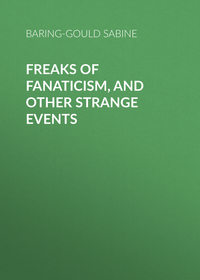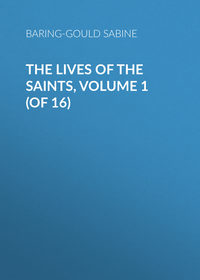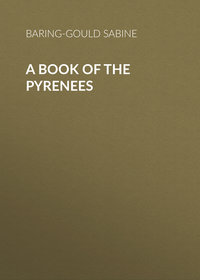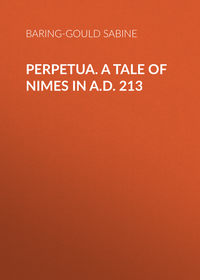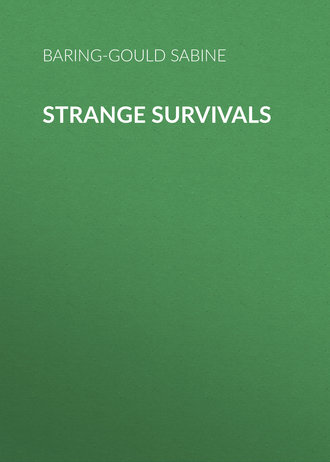 полная версия
полная версияStrange Survivals
That same night a friend of his was walking down a very lonely church lane, between hedges and fields, without a house near. In the loneliest, most haunted portion of this lane, his feet, his pulsation and his breath were suddenly arrested by the sight of a great black creature, occupying the middle of the way, shaking itself impatiently, moving forward, then bounding on one side, then running to the other. No saucer eyes, it is true, were visible, but it had a white nose that, to the horrified traveller, seemed lit with a supernatural phosphoric radiance. Being a man of intelligence, he would not admit to himself that he was confronted by the padfoot; he argued with himself that what he saw was a huge Newfoundland dog. So he addressed it in broad Yorkshire: “Sith’ere, lass, don’t be troublesome. There’s a bonny dog, let me pass. I’ve no stick. I wi’nt hurt thee. Come, lass, come, let me by.”
At that moment a blast rushed along the lane. The black dog, monster, padfoot, made a leap upon the terrified man, who screamed with fear. He felt claws in him, and he grasped – an umbrella. Mine!
That this idea of human victims being required to ensure the stability of a structure is by no means extinct, and that it constitutes a difficulty that has to be met and overcome in the East, will be seen from the following interesting extract from a recent number of the London and China Telegraph. The writer says: – “Ever and anon the idea gets abroad that a certain number of human bodies are wanted, in connection with laying the foundation of some building that is in progress; and a senseless panic ensues, and everyone fears to venture out after nightfall. The fact that not only is no proof forthcoming of anyone having been kidnapped, but that, on the contrary, the circle of friends and acquaintances is complete, quite fails to allay it. But is there ever any reasoning with superstition? The idea has somehow got started; it is a familiar one, and it finds ready credence. Nor is the belief confined either to race, creed, or locality. We find it cropping up in India and Korea, in China and Malaysia, and we have a strong impression of having read somewhere of its appearance in Persia. Like the notions of celibacy and retreat in religion, it is common property – the outcome, apparently, of a certain course of thought rather than of any peculiar surroundings. The description of the island of Solovetsk in Mr. Hepworth Dixon’s ‘Free Russia’ might serve, mutatis mutandis, for a description of Pootoo; and so a report of one of these building scares in China would serve equally well for the Straits. When the last mail left, an idea had got abroad among the Coolie population that a number of heads were required in laying the foundations of some Government works at Singapore; and so there was a general fear of venturing out after nightfall, lest the adventurer should be pounced on and decapitated. One might have thought the ways of the Singapore Government were better understood! That such ideas should get abroad about the requirements of Government even in China or Annam is curious enough; but the British Government of the Straits above all others! Yet there it is; the natives had got it into their heads that the Government stood in need of 960 human heads to ensure the safe completion of certain public works, and that 480 of the number were still wanting. Old residents in Shanghai will remember the outbreak of a very similar panic at Shanghai, in connection with the building of the cathedral. The idea got abroad that the Municipal Council wanted a certain number of human bodies to bury beneath the foundation of that edifice, and a general dread of venturing out after nightfall – especially of going past the cathedral compound – prevailed for weeks, with all kinds of variations and details. A similar notion was said to be at the bottom of the riots which broke out last autumn at Söul. Foreigners – the missionaries for choice – were accused of wanting children for some mysterious purpose, and the mob seized and decapitated in the public streets nine Korean officials who were said to have been parties to kidnapping victims to supply the want. This, however, seems more akin to the curious desire for infantile victims which was charged against missionaries in the famous Honan proclamation which preceded the Tientsin massacre, and which was one of the items in the indictment against the Roman Catholics on the occasion of that outbreak. Sometimes children’s brains are wanted for medicine, sometimes their eyes are wanted to compound material for photography. But these, although cognate, are not precisely similar superstitions to the one which now has bestirred the population of Singapore. A case came to us, however, last autumn, from Calcutta, which is so exactly on all fours with this latest manifestation, that it would almost seem as if the idea had travelled like an epidemic and broken out afresh in a congenial atmosphere. Four villagers of the Dinagepore district were convicted, last September, of causing the death of two Cabulis and injuring a third, for the precise reason that they had been kidnapping children to be sacrificed in connection with the building of a railway bridge over the Mahanuddi. A rumour had got abroad that such proceedings were in contemplation, and when these Cabulis came to trade with the villagers they were denounced as kidnappers and mobbed. Two were killed outright, their bodies being flung into the river; while the third, after being severely handled, escaped by hiding himself. We are not aware whether the origin of this curious fancy has ever been investigated and explained, for it may be taken for granted that, like other superstitions, it has its origin in some forgotten custom or faded belief of which a burlesque tradition only remains. This is not the place to go into a disquisition on the origin of human sacrifice; but it is not difficult to believe that, to people who believe in its efficacy, the idea of offering up human beings to propitiate the deity, when laying the foundations of a public edifice, would be natural enough. Whether the notion which crops up now and again, all over Asia, really represents the tradition of a practice – whether certain monarchs ever did bury human bodies, as we bury newspapers and coins, beneath the foundations of their palaces and temples, is a question we must leave others to answer. It is conceivable that they may have done so, as an extravagant form of sacrifice; and it is also conceivable that the abounding capacity of man for distorting superstitious imagery, may have come to transmute the idea of sacrificing human beings as a measure of propitiation, into that of employing human bodies as actual elements in the foundation itself. It is possible that the inhabitants of Dinagepore conserve the more ideal and spiritual view, which the practical Chinese mind has materialised, as in the recent instance at Singapore. Anyhow, the idea is sufficiently wide-spread and curious to deserve a word of examination as well as of passing record.”
When the north wall of the parish church of Chulmleigh in North Devon was taken down a few years ago – a wall of Perpendicular date – in it was found laid a very early carved figure of Christ crucified to a vine, or interlacing tree, such as is seen in so-called Runic monuments. The north wall having been falling in the fifteenth century, had been re-erected, and this figure was laid in it, and the wall erected over it, just as, in the same county, about the same time, the wall of Holsworthy Church was built over a human being. At Chulmleigh there was an advance in civilisation. The image was laid over the wall in place of the living victim.
When, in 1842, the remains of a Romano-Batavian temple were explored at Stinvezand, near Rysbergen, a singular mummy-like object was found under the foundation. This was doubtless a substitute for the human victim.
The stubborn prejudice which still exists in all parts against a first burial in a new cemetery or churchyard is due to the fact that in Pagan times the first to be buried was the victim, and in mediæval times was held to be the perquisite of the devil, who stepped into the place of the Pagan deity.
Every so-called Devil’s Bridge has some story associated with it pointing to sacrifice, and sometimes to the substitution of an animal for the human victim. The almost invariable story is that the devil had been invoked and promised his aid, if given the first life that passed over the bridge. On the completion of the structure a goat, or a dog, or a rabbit is driven over, and is torn to pieces by the devil. At Pont-la-Ville, near Courbières, is a four-arched Devil’s Bridge, where six mice, then six rats, and lastly six cats, were driven across, according to the popular story, in place of the eighteen human souls demanded by the Evil One.
At Cahors, in Ouercy, is a singularly fine bridge over the Lot, with three towers on it. The lower side of the middle tower could never be finished, it always gave way at one angle. The story goes that the devil was defrauded of his due – the soul of the architect – when he helped to build the bridge, and so declared that the bridge never should be finished. Of late years the tower has been completed, and in token that modern skill has triumphed, the Evil One has been represented on the angle, carved in stone. The legend shows that the vulgar thought that the bridge should have been laid in blood, and as it was not so, concluded that the faulty tower was due to the neglect of the Pagan usage.
The black dog that haunts Peel Castle, and the bloodhound of Launceston Castle, are the spectres of the animals buried under their walls, and so the White Ladies and luminous children, who are rumoured to appear in certain old mansions, are the faded recollections of the unfortunate sacrifices offered when these houses were first reared, not, perhaps, the present buildings, but the original manor-halls before the Conquest.
At Coatham, in Yorkshire, is a house where a little child is seen occasionally – it vanishes when pursued. In some German castles the apparition of a child is called the “Still child;” it is deadly pale, white-clothed, with a wreath on the head. At Falkenstein, near Erfurth, the appearance is that of a little maiden of ten, white as a sheet, with long double plaits of hair. A white baby haunts Lünisberg, near Aerzen. I have heard of a house in the West of England, where on a pane of glass, every cold morning, is found the scribbling of little fingers. However often the glass be cleaned, the marks of the ghostly fingers return. The Cauld Lad of Hilton Castle in the valley of Wear is well known. He is said to wail at night:
“Wae’s me, wae’s me,The acorn’s not yetFallen from the treeThat’s to grow the wood,That’s to make the cradle,That’s to rock the bairn,That’s to grow to a man,That’s to lay me.”At Guilsland, in Cumberland, is another Cauld Lad; he is deadly white, and appears ever shivering with cold, and his teeth chattering.
An allied apparition is that of the Radiant Boy. Lord Castlereagh is said to have seen one, a spectre, which the owner of the castle where he saw it admitted had been visible to many others. Dr. Kerner mentions a very similar story, wherein an advocate and his wife were awakened by a noise and a light, and saw a beautiful child enveloped in a sort of glory. I have heard of a similar appearance in a Lincolnshire house. A story was told me, second-hand, the other day, of a house where such a child was seen, which always disappeared at the hearth, and sometimes, instead of the child, little white hands were observed held up appealingly above the hearthstone. The stone was taken up, quite recently, and some bones found under it, which were submitted to an eminent comparative anatomist, who pronounced them to be those of a child.
Mrs. Crowe, in her “Night Side of Nature,” gives an account of such an apparition from an eye-witness, dated 1824. “Soon after we went to bed, we fell asleep: it might be between one and two in the morning when I awoke. I observed that the fire was totally extinguished; but, although that was the case, and we had no light, I saw a glimmer in the centre of the room, which suddenly increased to a bright flame. I looked out, apprehending that something had caught fire, when, to my amazement, I beheld a beautiful boy standing by my bedside, in which position he remained some minutes, fixing his eyes upon me with a mild and benevolent expression. He then glided gently away towards the side of the chimney, where it is obvious there is no possible egress, and entirely disappeared. I found myself in total darkness, and all remained quiet until the usual hour of rising. I declare this to be a true account of what I saw at C – Castle, upon my word as a clergyman.”
When we consider that the hearth is the centre and sacred spot of a house, and that the chimney above it is the highest portion built, and the most difficult to rear, it is by no means improbable that the victim was buried under the hearthstone or jamb of the chimney. The case already mentioned of a child’s bones having been found in this position is by no means an isolated one.
It would be impossible to give a tithe of the stories of White Ladies and Black Ladies and Brown Ladies who haunt old houses and castles.
The latest instance of a human being having been immured alive, of which a record remains and which is well authenticated, is that of Geronimo of Oran, in the wall of the fort near the gate Bab-el-oved, of Algiers, in 1569. The fort is composed of blocks of pise, a concrete made of stones, lime, and sand, mixed in certain proportions, trodden down and rammed hard into a mould, and exposed to dry in the sun. When thoroughly baked and solid it is turned out of the mould, and is then ready for use. Geronimo was a Christian, who had served in a Spanish regiment; he was taken by pirates and made over to the Dey of Algiers. When the fort was in construction, Geronimo was put into one of the moulds, and the concrete rammed round him (18th Sept., 1569), and then the block was put into the walls. Don Diego de Haedo, the contemporary author of the “Topography of Algiers,” says, “On examining with attention the blocks of pise which form the walls of the fort, a block will be observed in the north wall of which the surface has sunk in, and looks as if it had been disturbed; for the body in decaying left a hollow in the block, which has caused the sinkage.”
On December 27, 1853, the block was extracted. The old fort was demolished to make room for the modern “Fort des vingt-quatre-heures,” under the direction of Captain Susoni, when a petard which had been placed beneath two or three courses of pise near the ground, exploded, and exposed a cavity containing a human skeleton, the whole of which was visible, from the neck to the knees, in a perfect state of preservation. The remains, the cast of the head, and the broken block of pise, are now in the Cathedral of Algiers.
The walls of Scutari are said also to contain the body of a victim; in this case of a woman, who was built in, but an opening was left through which her infant might be passed in to be suckled by her as long as life remained in the poor creature, after which the hole was closed.
At Arta also, in the vilajet of Janina, a woman was walled into the foundation of the bridge. The gravelly soil gave way, and it was decided that the only means by which the substructure could be solidified was by a human life. One of the mason’s wives brought her husband a bowl with his dinner, when he dropped his ring into the hole dug for the pier, and asked her to search for it. When she descended into the pit, the masons threw in lime and stones upon her, and buried her.
The following story is told of several churches in Europe. The masons could not get the walls to stand, and they resolved among themselves to bury under them the first woman or child that came to their works. They took oath to this effect. The first to arrive was the wife of the master-mason, who came with the dinner. The men at once fell on her and walled her into the foundations. One version of the story is less gruesome. The masons had provided meat for their work, and the wife of the master had dealt so carelessly with the provision, that it ran out before the building was much advanced. She accordingly put the remaining bones into a cauldron, and made a soup of vegetables. When she brought it to the mason, he flew into a rage, and built the cauldron and bones into the wall, as a perpetual caution to improvident wives. This is the story told of the church of Notre Dame at Bruges, where the cauldron and bones are supposed to be still seen in the wall. At Tuckebrande are two basins built into the wall, and various legends not agreeing with one another are told to account for their presence. Perhaps these cauldrons contained the blood of victims of some sort immured to secure the stability of the edifice.3
A very curious usage prevails in Roumania and Transylvania to the present day, which is a reminiscence of the old interment in the foundations of a house. When masons are engaged on the erection of a new dwelling, they endeavour to catch the shadow of a stranger passing by and wall it in, and throw in stones and mortar whilst his shadow rests on the walls. If no one goes by to cast his shade on the stones, the masons go in quest of a woman or child, who does not belong to the place, and, unperceived by the person, apply a reed to the shadow, and this reed is then immured; and it is believed that when this is done, the woman or child thus measured will languish and die, but luck attaches to the house. In this we see the survival of the old confusion between soul and shade. The Manes are the shadows of the dead. In some places it is said that a man who has sold his soul to the devil is shadowless, because soul and shadow are one. But there are other instances of substitution hardly less curious. In Holland have been found immured in foundations curious objects like ninepins, but which are really rude imitations of babes in their swaddling-bands. When it became unlawful to bury a child, an image representing it was laid in the wall in its place. Another usage was to immure an egg. The egg had in it life, but undeveloped life, so that by walling it in the principle of sacrificing a life was maintained without any shock to human feelings. Another form of substitution was that of a candle. From an early period the candle was burnt in place of the sacrifice of a human victim. At Heliopolis, till the reign of Amasis, three men were daily sacrificed; but when Amasis expelled the Hyksos kings, he abolished these human offerings, and ordered that in their place three candles should be burned daily on the altar. In Italy, wax figures, sometimes figures of straw, were burnt in the place of the former bloody sacrifices.
In the classic tale, at the birth of Meleager, the three fates were present; Atropos foretold that he would live as long as the brand then burning on the hearth remained unconsumed; thereupon his mother, Althæa, snatched it from the fire, and concealed it in a chest. When, in after years, Meleager slew one of his mother’s brothers, she, in a paroxysm of rage and vengeance, drew forth the brand, and burnt it, whereupon Meleager died.
In Norse mythology a similar tale is found. The Norns wandered over the earth, and were one night given shelter by the father of Nornagest; the child lay in a cradle, with two candles burning at the head. The first two of the Norns bestowed luck and wealth on the child; but the third and youngest, having been thrust from her stool in the crush, uttered the curse, “The child shall live no longer than these candles burn.” Instantly the eldest of the fateful sisters snatched the candles up, extinguished them, and gave them to the mother, with a warning to take good heed of them.
A story found in Ireland, and Cornwall, and elsewhere, is to this effect. A man has sold himself to the devil. When the time comes for him to die, he is in great alarm; then his wife, or a priest, persuades the devil to let him live as long as a candle is unconsumed. At once the candle is extinguished, and hidden where it can never be found. It is said that a candle is immured in the chancel wall of Bridgerule Church, no one knows exactly where. A few years ago, in a tower of St. Osyth’s Priory, Essex, a tallow candle was discovered built in.
As the ancients associated shadow and soul, so does the superstitious mind nowadays connect soul with flame. The corpse-candle which comes from a churchyard and goes to the house where one is to die, and hovers on the doorstep, is one form of this idea. In a family in the West of England the elder of two children had died. On the night of the funeral the parents saw a little flame come in through the key-hole and run up to the side of the cradle where the baby lay. It hovered about it, and presently two little flames went back through the key-hole. The baby was then found to be dead.
In the Arabic metaphysical romance of “Yokkdan,” the hero, who is brought up by a she-goat on a solitary island, seeks to discover the principle of life. He finds that the soul is a whitish luminous vapour in one of the cavities of the heart, and it burns his finger when he touches it.
In the German household tale of “Godfather Death,” a daring man enters a cave, where he finds a number of candles burning; each represents a man, and when the light expires, that man whom it represents dies. “Jack o’ lanterns” are the spirits of men who have removed landmarks. One of Hebel’s charming Allemanic poems has reference to this superstition.
The extinguished torch represents the departed life, and in Yorkshire it was at one time customary to bury a candle in a coffin, the modern explanation being that the deceased needed it to light him on his road to Paradise; but in reality it represented an extinguished life, and probably was a substitute for the human sacrifice which in Pagan times accompanied a burial. In almost all the old vaults opened in Woodbury Church, Devon, candles have been found affixed to the walls. The lamps set in graves in Italy and Greece were due to the same idea. The candle took the place of a life, as a dog or sow in other places was killed instead of a child.
It is curious and significant that great works of art and architecture should be associated with tragedies. The Roslyn pillar, the Amiens rose window, the Strassburg clock, many spires, and churches. The architect of Cologne sold himself to the devil to obtain the plan. A master and an apprentice carve pillars or construct windows, and because the apprentice’s work is best, his master murders him. The mechanician of a clock is blinded, some say killed, to prevent him from making another like it. Perdix, for inventing the compass, was cast down a tower by Daedalus.
It will be remembered that the architect of Cologne Cathedral, according to the legend, sold himself to the devil for the plan, and forfeited his life when the building was in progress. This really means that the man voluntarily gave himself up to death, probably to be laid under the tower or at the foundation of the choir, to ensure the stability of the enormous superstructure, which he supposed could not be held up in any other way.
An inspector of dams on the Elbe, in 1813, in his “Praxis,” relates that, as he was engaged on a peculiarly difficult dyke, an old peasant advised him to get a child, and sink it under the foundations.
As an instance of even later date to which the belief in the necessity of a sacrifice lingered, I may mention that, in 1843, a new bridge was about to be built at Halle, in Germany. The people insisted to the architect and masons that their attempt to make the piers secure was useless, unless they first immured a living child in the basement. We may be very confident that if only fifty years ago people could be found so ignorant and so superstitious as to desire to commit such an atrocious crime, they would not have been restrained in the Middle Ages from carrying their purpose into execution.
I have already said that originally the sacrifice was offered to the Earth goddess, to propitiate her, and obtain her consent to the appropriation of the soil and to bearing the burden imposed on it. But the sacrifice had a further meaning. The world itself, the universe, was a vast fabric, and in almost all cosmogonies the foundations of the world are laid in blood. Creation rises out of death. The Norsemen held that the giant Ymir was slain, that out of his body the world might be built up. His bones formed the rocks, his flesh the soil, his blood the rivers, and his hair the trees and herbage. So among the Greeks Dionysos Zagreus was the Earth deity, slain by the Titans, and from his torn flesh sprang corn and the vine, the grapes were inflated with his blood, and the earth, his flesh, transubstantiated into bread. In India, Brahma gave himself to form the universe. “Purusha is this All; his head is heaven, the sun is fashioned out of his eyes, the moon out of his heart, fire comes from his mouth, the winds are his breath, from his navel is the atmosphere, from his ears the quarters of the world, and the earth is trodden out of his feet” (“Rig. Veda” viii. c. 4, hymn 17-19).



